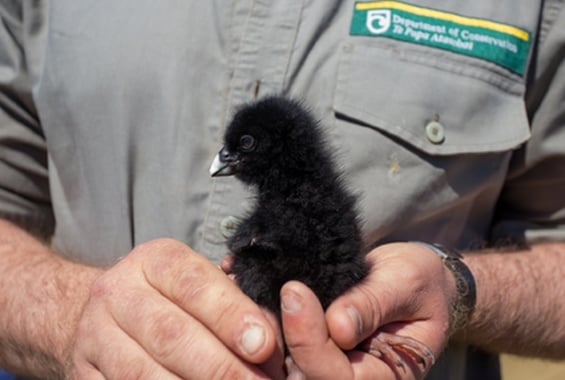Archived content: This media release was accurate on the date of publication.
Date: 12 March 2015
Once presumed extinct, the critically endangered takahē has had a hugely successful breeding season thanks to work undertaken by the Department of Conservation (DOC) in partnership with Mitre 10.
DOC’s Takahē Recovery Team have reared almost twice the number of takahē chicks than their previous best season. The large number of chicks hatched and reared this summer makes this the best breeding season in the Burwood Bush Takahe Rearing Unit’s 30 year history.

Takahē chick
“The breeding unit has produced 25 chicks and when we combine that with chicks from pest-free islands and mainland islands we are looking at almost 40 chicks,” says DOC Takahē Ranger Glen Greaves.
“Given the very low numbers of takahē, these incredibly valuable young birds,
will boost the existing population by more than 15%.”
Working in partnership with Mitre 10, DOC attributes the hugely successful season to increasing captive breeding pairs, investment in new breeding pens and a move away from intensive hand rearing.
“We’ve been working with DOC to increase the breeding success at Burwood for a number of years,” says Mitre 10 General Manager Marketing, Dave Elliott.
“This has involved building more pens to enable the facility to now hold up to 23 breeding pairs in as natural an environment as possible.”
The previous best breeding season reared 19 birds and included eggs and chicks collected from the last wild takahē population in the Murchison Mountains.
“The high number of chicks now thriving in Burwood will allow DOC’s Takahē Recovery Team to supplement takahē in the Murchison Mountains, which has declined significantly from repeated stoat plagues,” says Glen Greaves.
“There is now an extensive trapping regime in the mountains to protect this population.”
In order to secure the future of the species, the takahē team have been working to increase the number of breeding pairs in secure (predator-free) islands and sanctuaries across New Zealand.
“With this level of breeding success we are under more pressure than ever to free up good breeding territories and find safe homes for takahē,” says Glen Greaves.
Next week seven takahē will be transferred from Mana Island to three sites in the North Island. Five of the birds are sub-adults which will be used to boost the breeding populations at Tawharanui Open Sanctuary and on Motutapu Island. The other two older birds will be retired to Wairakei Golf + Sanctuary to free up breeding space on Mana Island.
Contact
Lizzy Sutcliffe, Media Advisor
Phone: +64 3 363 1660
Mobile: +64 27 886 3507